Unlock the secrets to achieving your full potential with strategic professional goal setting – maximize your growth and success now!
Table of Contents
Introduction to Professional Growth
professional growth and development are important because they help you get better at your job. When you grow professionally, you learn new things, improve your skills, and become more valuable to your company. It’s like leveling up in a video game – you become stronger and more capable.
Personal and professional development go hand in hand. Personal development is about improving yourself as a person, while professional development focuses on improving your skills and knowledge related to your job. Both are essential for your success in the workplace.
Understanding SMART Goals
Setting goals is an essential part of growing in your job. But have you ever heard of SMART goals for professional development? Let’s dive into what SMART goals are and why they are a great way to help you improve at work.
What Does SMART Stand For?
SMART stands for Specific, Measurable, Achievable, Relevant, and Time-Bound. Let’s break it down:
- Specific: Your goal should be clear and well-defined. Instead of saying, “I want to get better at my job,” a specific goal would be, “I want to improve my customer service skills by handling customer complaints more efficiently.”
- Measurable: Your goal should have a way to measure your progress. This could be tracking the number of customer complaints you resolve successfully each week.
- Achievable: Your goal should be something that you can realistically accomplish. It’s great to aim high, but make sure it’s something within your reach.
- Relevant: Your goal should matter to you and align with your overall career objectives. Make sure it’s something that will help you grow in your job.
- Time-Bound: Your goal should have a deadline. Setting a timeframe helps you stay focused and motivated to work towards achieving it.
Examples of SMART Goals
Now, let’s look at some examples of SMART goals in action:
- Specific: “I will complete a project management course to improve my skills in leading cross-functional teams.”
- Measurable: “I will increase my sales by 10% in the next quarter by reaching out to 20 new clients each week.”
- Achievable: “I will learn a new programming language to enhance my technical capabilities within six months.”
- Relevant: “I will attend networking events to expand my professional connections and explore new career opportunities.”
- Time-Bound: “I will complete my certification exam by the end of this year to advance my career.”
Creating Your Personal Professional Development Plan
When you want to get better at your job, it’s important to have a plan in place. This section will guide you on how to make your own personal professional development plan to help you grow in your career.

Image courtesy of wepik.com via Google Images
Identifying Growth Areas
Before you can start setting goals for yourself, you need to figure out which areas you want to improve in. Take some time to think about the parts of your job that you find challenging or where you think you could do better. Are there specific skills you want to learn or tasks you want to become more efficient at? Identifying these growth areas will help you focus your efforts and make your goals more targeted.
Setting Your Professional Development Goals
Once you have identified the areas you want to work on, it’s time to set your professional development goals. Remember, your goals should be SMART: Specific, Measurable, Achievable, Relevant, and Time-Bound. For example, instead of saying “I want to get better at presentations,” a SMART goal would be “I will enroll in a public speaking course and practice delivering three presentations at work by the end of the quarter.” Setting clear and specific goals will give you a roadmap to follow and help you track your progress along the way.
Working on Your Goals Every Day
In order to achieve your personal development goals for work, it’s essential to work on them consistently. By taking small steps every day, you can make progress towards your professional growth. Here, we’ll explore some daily habits that can help you reach your goals.
Daily Habits for Professional Growth
One simple daily habit for professional growth is setting aside time each day to reflect on your progress towards your goals. This could involve reviewing the tasks you completed, identifying any challenges you faced, and thinking about what you can do differently the next day.
Another important daily habit is to seek feedback from your colleagues or supervisors. By asking for input on your work, you can gain valuable insights that can help you improve and grow in your role. Additionally, offering to help your coworkers with their tasks can also be a great way to learn new skills and expand your knowledge.
Furthermore, dedicating time each day to learn something new related to your job can contribute significantly to your professional development. This could involve reading industry articles, taking online courses, or attending relevant workshops and seminars.
Lastly, practicing good time management skills and prioritizing your tasks effectively can help you stay focused on your goals and make steady progress. By breaking down your larger goals into smaller, manageable tasks, you can ensure that you are consistently moving towards your objectives.
Balancing Personal and Professional Development
In our busy lives, it’s essential to find a balance between growing in our careers and taking care of ourselves. Let’s explore how you can achieve personal and professional development while still prioritizing your well-being.
| Goal | Action Plan | Timeline |
|---|---|---|
| Improve Time Management Skills | Start using a digital calendar, prioritize tasks, limit distractions | 3 months |
| Enhance Communication Skills | Take a public speaking course, practice active listening, seek feedback | 6 months |
| Expand Professional Network | Attend industry events, join networking groups, connect on LinkedIn | Ongoing |
| Acquire New Skills | Take online courses, attend workshops, seek mentorship | 1 year |

Image courtesy of www.peoplebox.ai via Google Images
Making Time for Yourself
While setting goals and working towards professional growth is important, it’s equally crucial to make time for yourself. Taking breaks, pursuing hobbies, and spending time with loved ones can help you recharge and stay motivated. Remember, a healthy work-life balance is key to long-term success.
Tracking Your Progress
In this part, we will learn how to know if you are getting closer to your goals.
Tools and Techniques for Measuring Success
There are many ways to see if you are making progress towards your goals. One tool you can use is a checklist. A checklist is like a to-do list, but it helps you keep track of the steps you need to take to reach your goal. By checking off each item on the list, you can see how far you’ve come.
Another helpful tool is a progress journal. This is a notebook where you can write down what you did each day to work towards your goal. By looking back at your journal, you can see how much you have accomplished and what you still need to do.
You can also use a calendar to set deadlines for yourself. This will help you stay on track and make sure you are working towards your goal consistently.
Remember, it’s important to be patient with yourself. Progress takes time, and it’s okay if you don’t see big changes right away. By using these tools and techniques, you can stay motivated and focused on reaching your goals for professional development.
Adjusting Your Goals as You Grow
In your professional journey, it’s normal for things to change. As you learn new things and grow, you may find that your goals need to be adjusted. This is a natural part of the process, and it’s essential to be flexible and willing to adapt. Let’s delve into what you can do when you realize it’s time to make some changes to your goals.
When Is It Time to Set New Goals?
One key indicator that it may be time to set new goals is when you’ve achieved your current ones. If you find yourself reaching the objectives you set out for, it’s a sign that you’re ready to tackle new challenges and set higher targets. Celebrate your accomplishments, but don’t be afraid to aim even higher.
Another instance where adjusting your goals may be necessary is when you encounter unexpected obstacles or opportunities. Life is full of surprises, and sometimes you may need to pivot to make the most of a new situation. Being open to change and reassessing your goals accordingly can lead to even greater success.
Furthermore, as you gain more experience and skills in your job, your aspirations may evolve. What seemed like a significant goal when you started out may now feel too easy or not quite relevant anymore. It’s crucial to regularly evaluate your goals to ensure they continue to challenge and motivate you.
Remember, setting new goals doesn’t mean that you’ve failed at your previous ones. It simply means that you’re growing and advancing in your career. Embrace these changes as opportunities for personal and professional development, and keep pushing yourself to reach new heights.
In the next section, we’ll explore some common questions about setting professional goals and how to handle challenges along the way.
Conclusion
In this blog post, we explored the world of professional growth and development, focusing on how setting smart goals can help you improve in your job. By understanding the importance of personal and professional development, you can create a personal professional development plan that aligns with your aspirations.

Image courtesy of wepik.com via Google Images
SMART goals for professional development are essential because they are Specific, Measurable, Achievable, Relevant, and Time-Bound. These goals provide a clear roadmap for your growth, ensuring that your efforts are targeted and effective.
Remember, identifying areas for growth, setting clear goals, and working on them every day are key components of your journey towards success. Balancing personal and professional development is crucial for maintaining a healthy work-life equilibrium.
Tracking your progress allows you to stay on course and make adjustments as needed. If you find that your goals no longer align with your aspirations or circumstances, don’t be afraid to set new ones that reflect your growth and learning.
By following the steps outlined in this blog post and staying committed to your personal development goals for work, you can maximize your growth and achieve professional success. Remember, continuous improvement is the key to unlocking your full potential.
Frequently Asked Questions (FAQs)
This section will answer some common questions about setting professional goals.
What if I don’t reach my goal in time?
If it takes longer than you thought to reach your goal, don’t worry! It’s okay to adjust your timeline. Take a look at why you might be behind schedule. Maybe the goal was too ambitious, or unexpected things came up. Reflect on what went wrong and make a new plan with a more realistic timeframe. Remember, it’s all about progress, not perfection!
Can I have more than one goal at the same time?
Absolutely! It’s totally fine to work on multiple goals simultaneously. Just make sure they don’t overwhelm you. Having a few manageable goals can keep you motivated and engaged. However, if you find yourself spreading too thin, it might be helpful to prioritize and focus on one goal at a time. Listen to your needs and adjust accordingly to make the most out of your personal and professional growth journey.


Leave a Reply